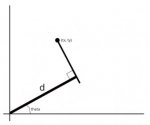Stuck on a seemingly simple geometry problem
I'm working on a program, and stuck on something that's reduced nicely to this 2D geometry problem.

I have a line with a known length (d) free to rotate around the origin. Perpandicular to the end of that line is another line that passes through a known point (tx, ty). What is the angle theta ?
I'm working on a program, and stuck on something that's reduced nicely to this 2D geometry problem.

I have a line with a known length (d) free to rotate around the origin. Perpandicular to the end of that line is another line that passes through a known point (tx, ty). What is the angle theta ?
Last edited:
